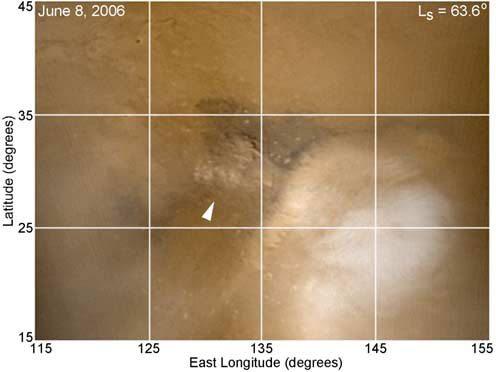Lightning Detected on Mars

The first detection of lightning in a Martian dust storm haslikely been made by a new detector on a radio telescope.
Scientists have long thought that as with dust devils and stormshere on Earth, Martiandust storms should produce lightning. But direct evidence of electricdischarges on the red planet was lacking.
That's where an innovative detector installed in a 34-meterradio telescope in the Deep Space Network lent a hand.
This detector captured the signature of the radiation givenoff by the lightning for a few hours during a Martian dust storm on June 8, 2006.
"We saw the lightning," said Christopher Ruf ofthe University of Michigan in Ann Arbor, who first developed the new detector for use on Earth-orbiting weather satellites.
While lightning was expected to occur on Mars, "it wasa surprise that the signal was so strong," Ruf told SPACE.com.
The lightning wouldn't look quite like whatwe see on Earth during a thunderstorm ? "It wouldn't likely be the biglightning bolts," Ruf said, instead it would look more like a glow in theclouds, akin to so-called heat lightning here on Earth.
Breaking space news, the latest updates on rocket launches, skywatching events and more!
The dust storm the lightning was detected in was a majorone, measuring 22 miles (35 kilometers) deep, but "it should be there insmaller storms" too, Ruf said.
"These dust storms happen all the time there," headded.
The lightning isn't a major worry for the rovers currently on the Martiansurface (or any future robotic or human explorers), because to cause a problem,the discharge would have to occur in the cloud right at the location of therover.
But the lightning could cause chemical reaction that affectthe chemistry of the Martian atmosphere and surface, creating caustic compoundsthat would affect human equipment and would have to be factored into designs,Ruf explained.
Another intriguing consideration is how lightning mightaffect the possibility of past or present life on Mars. Life is more likely tooccur with lightning than without, Ruf said, because electric currents make formore complex molecules, but Ruf isn't holding his breath.
Scientists are working to install more sensitive detectorson telescopes to see if they can make more measurements of Martian lightning inthe future.
Ruf and his colleagues detailed their observations in theJuly 11 issue of the journal Geophysical Research Letters.
- The Wildest Weather in the Galaxy
- Mars Madness: A Multimedia Adventure!
- The 10 Best Mars Images Ever

Andrea Thompson is an associate editor at Scientific American, where she covers sustainability, energy and the environment. Prior to that, she was a senior writer covering climate science at Climate Central and a reporter and editor at Live Science, where she primarily covered Earth science and the environment. She holds a graduate degree in science health and environmental reporting from New York University, as well as a bachelor of science and and masters of science in atmospheric chemistry from the Georgia Institute of Technology.
